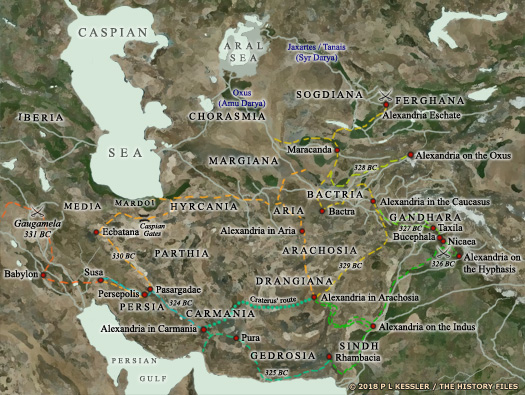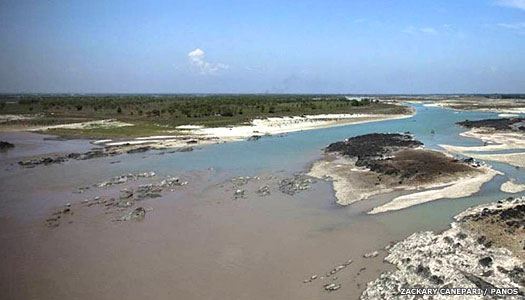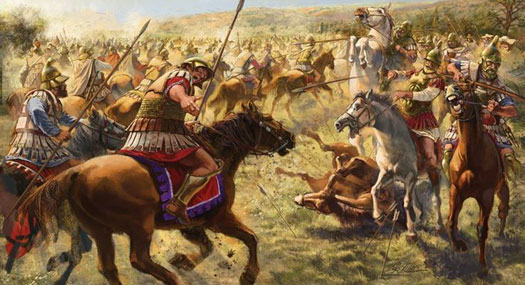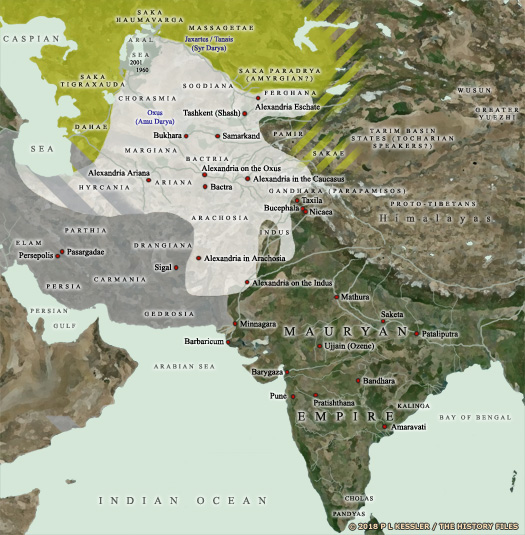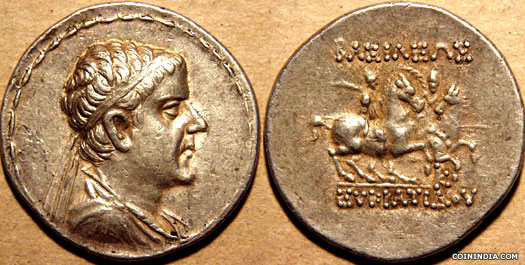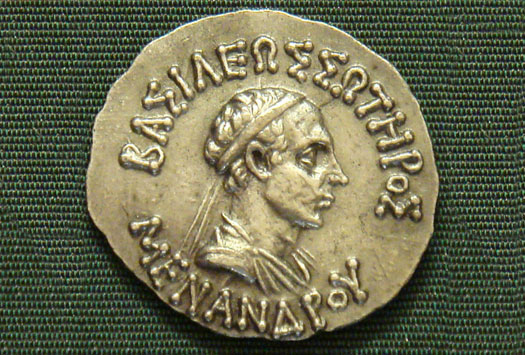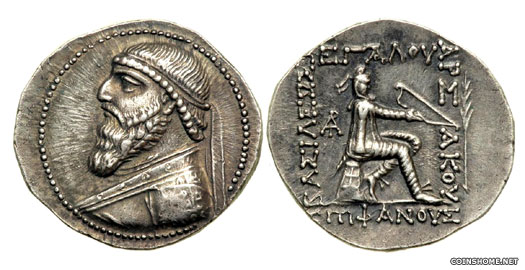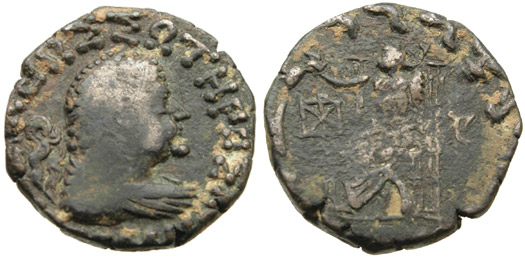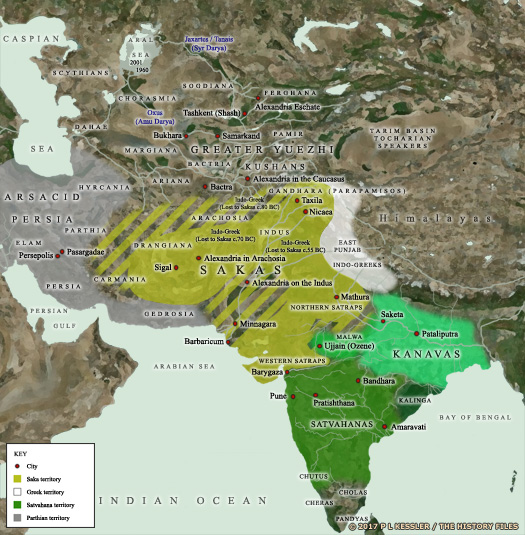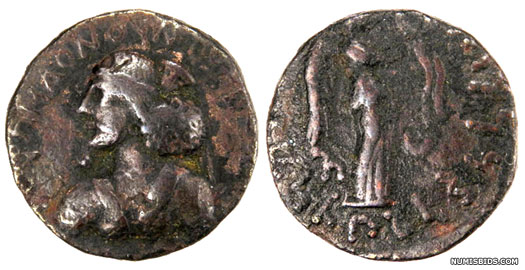
| Incorporating
the Sattagydai :
The ancient regions of the Indus lay on the eastern side of the Hindu Kush mountains. Although rarely defined with any specific borders, they generally followed the River Indus and its tributaries from their headwaters the north, incorporating the foothills of the Himalayas, to the Indus delta in the south. This area had witnessed the rise and fall of one of the earliest civilisations, the Indus Valley culture, between the late fourth millennium and around 1700 BC. Then it had seen the widespread Indo-Aryan migrations from west to east, and had settled into a patchwork of Indo-Aryan states or tribal regions before the arrival of the Persians. Today this region falls largely within Pakistan's borders, although throughout history it has generally been seen as part of a greater India.
The northern part of the Indus river valley was known during the early days of the Persian empire as Thatagush, a Persian corruption of an unknown tribal name which the Greek writer Herodotus rendered as Sattagydai and which later Latin writers amended to Satagydae. The Persian form of the tribal name itself was Thatagu. 'Sattagydai' would be the physical area occupied by the tribe. The tribe would be the Satagydoi, using the Greek plural '-oi'. Removing this plural suffix leaves a core name of Satagyd. As for meaning, the first part of the name, 'sata-', is probably a form of satem, possibly meaning 'hundred' (see note, below). The 'gu-' in the Persian form of the name is possibly 'cow', and could be amended to the Greek 'gy-' by shortening the 'u'. The 'd' must remain unknown for the moment - perhaps it is a suffix added to the 'gu-'. The Persians may have dropped the 'd' because it was actually a 'th'. If the translation of 'hundred' is correct then the overall meaning could be 'hundred herds' or 'hundred herders'. Think of it in terms of Texan herders - 'hundred cowboys'! Indo-European groups were notable for their cow herds, and also for cattle stealing exploits, so it would be a fitting name for their Indo-Aryan descendants in the Indus Valley.
They have been presumed to be 'of Indian stock', seemingly only by modern writers. In reality, this would mean that they were an Indo-Aryan folk (or at least an Indo-Aryan warrior elite ruling an earlier population) who were closely related to all of their regional neighbours both in the Indus valley and to the west of the Hindu Kush mountains.
Note: Indo-European (IE) language can be divided into centum (the westernmost West IEs and Tocharians) and satem languages (the rest, including Indo-Iranians). The former pronounced 'hundred' with a 'k' as 'kentum' (plus variants and evolutions, notably Latin softening the 'k' to a 'c' as centum), and the latter using an 's' as satem (in Avestan - the Persian form was sad).
(Additional information by Edward Dawson, from The Persian Empire, J M Cook (1983), from The Histories, Herodotus (Penguin, 1996), and from External Links: Old Iranian - Online Avestan Master Glossary (University of Texas at Austin), and Dictionary of most common Avesta words.)
c.546 - 540 BC :
The defeat of the Medes opens the floodgates for Cyrus the Great with a wave of conquests, beginning in the west from 549 BC but focussing towards the east of the Persians from about 546 BC. Eastern Iran falls during a more drawn-out campaign between about 546-540 BC, which may be when Maka is taken (presumed to be the southern coastal strip of the Arabian Sea). Further eastern regions now fall, namely Arachosia, Aria, Bactria, Carmania, Chorasmia, Drangiana, Gandhar, Gedrosia, Hyrcania, Margiana, Parthia, Saka (at least part of the broad tribal lands of the Sakas), Sogdiana (with Ferghana), and Thatagush - all added to the empire, although records for these campaigns are characteristically sparse.
Persian
Satraps of Thatagush (Θatagu / Sattagydia) :
Conquered in the mid-sixth century BC by Cyrus the Great, the northern Indus region was added to the Persian empire. Before that it was populated by tribal groups or small kingdoms, all of whom - by the first millennium BC - would have been dominated by Indo-Aryan people, or at least an Indo-Aryan warrior elite which governed an indigenous group. Unlike the other eastern regions of the empire, which were ancestral homelands for the Persians, the territories of the Indus were less familiar. Even so, given the Indo-Aryan migrations through this region over the preceding millennium, there were probably no language barriers for the forces of Cyrus and few cultural differences. Although details of his conquests in the Indus are poor, he seemingly experienced few problems in uniting the various groups here under his governance.
Prior to the reorganisations under Darius the Great, the northern Indus was organised into a province called Thatagush (this can also be referred to as 'Northern Punjab' in some sources and Θatagu in Persian sources). The name Thatagush is a Persian corruption of the name of the tribe which occupied the valley, which the Greek writer Herodotus rendered as Sattagydai. To add to the confusion, this name can also be used in some sources to denote the province in the form of Sattagydia. Sattagydia could also be used to determine not one but three minor satrapies within Thatagush. One of these was along the Indus, one was to the north of Taxila (with Taxila - now known as Sirkap - probably providing the province with its capital), and one was to the east of the Hydaspes - the eastern frontier of the Achaemenid empire.
Although not too much is known about Thatagush, it is clear that the River Indus formed its border with Harahuwatish (Arachosia). One of the most informative sources when attempting to reconstruct the satrapal administration of Harahuwatish and Gedrosia is that of Alexander's appointments. In northern Harahuwatish, when he first encountered its large administrative complex, Alexander made important decisions about Zranka, Gedrosia, and Hindush. These regions were therefore subsumed in the Arachosian administrative complex, and this may have been the case in Persian times too. In the form of Sattagydia, Thatagush certainly also seems to be part of the territories of the satrap of Harahuwatish during the rebellions which followed the accession of Darius the Great in 522-521 BC. The Babylonian version of the Behistun inscription clearly links the two provinces together at this time, while the inscription also shows that Thatagush was already part of the empire when Darius acceded the throne.
(Additional information from The Persian Empire, J M Cook (1983), from The Histories, Herodotus (Penguin, 1996), from Persica, Ctesias of Cnidus (original work lost but a section is repeated by Photius in ninth century AD Constantinople), and from External Links: Encyclopaedia Iranica, and Livius.org.)
fl 522/521 BC :
Vivāna : Satrap, with Harahuwatish. Appointed by Cambyses.
522 - 521 BC :
Immediately after Darius I secures the throne he faces several rebellions, stretching from Babirush to Media and Armina to Parthawa, and Verkāna. The responses to all of these are handled well by Darius and all are crushed in turn. Another major rebellion in Mergu happens towards the end of 522 or 521 BC and that too is put down.
Darius mentions that the the 'false' king he had replaced on the Achaemenid throne, Smerdis (otherwise known as Vahyazdāta), had sent his own satrap to govern Harahuwatish with orders to put down the present incumbent. The two sides meet (or have met) in battle at a fortress called Kapia-kani (probably Kapisa). Quite possibly Vivāna is besieged for several weeks before assembling for battle in December 522 BC. Vivāna's forces are victorious, but the rebels are able to regroup and offer battle again at Gandutava. This time they are crushed, although the 'false' satrap is able to flee to a fortress called Arādā, still within Harahuwatish and possibly Vivāna's personal headquarters in the province. Vivāna and his army march after them on foot and at the fortress they are seized and killed (in February 521 BC).
The emergency in Harahuwatish is over. The 'false' satrap seems not to be mentioned by name, a good way of ensuring that history forgets him. However, there may still be rebel elements in Thatagush, as Darius conducts a campaign there, during which he also seems to secure a new satrapy by the name of Hindush. Some of this territory is already likely to have been part of the conquests of Cyrus the Great, but it is possible that Darius now extends and completes the conquest.
fl c.510s BC :
Bagabadush / Megabazus : First cousin of Darius I. Satrap? With Gadara & Harahuwatish.
513 BC :
The unreliable Ctesias claims that Darius orders Ariaramnes, satrap of Katpatuka, to cross the Black Sea to conduct a preliminary reconnaissance of the Scythian territories there. Ariaramnes brings back prisoners which include the brother of the Scythian king, and the resultant protests give Darius his excuse to go to war in Scythia. Following the failure of the campaign, Darius leaves Megabazus in command of the troops.
This could be the Bagabadush who is named in a Persepolis tablet as the later satrap of Harahuwatish (and, presumably, Thatagush too - the latter form of the name is usually taken as the Old Persian version of the former). It could also be the same Megabazus who commands the Persian forces in the west and later becomes satrap of Daskyleion.
360s/350s BC :
Artaxerxes II is occupied fighting the 'revolt of the satraps' in the western part of the empire. Nothing is known of events in the eastern half of the Persian empire at this time, but no word of unrest is mentioned by Greek writers, however briefly. Given the newsworthiness for Greeks of any rebellion against the Persian king, this should be enough to show that the east remains solidly behind the king. It seems that all of the empire's troubles hinge on the Greeks during this period.
330s BC :
By this time, Persian control of Hindush and Thatagush seems either to have weakened or has been devolved. Three kingships are known from Alexander's campaigns in the region in 327-326 BC and must therefore exist prior to his arrival as two of them are in a state of ongoing conflict. A similar situation exists in Hindush.
King Ambhi rules Taxila (Takshasila, now known as Sirkap), an important town on the eastern bank of the River Indus close to its northern headwaters, and immediately opposite the province of Gadara (now in northern Pakistan). Having served as the Persian capital of the Hindush satrapy, it commands access to three important trade routes, one of these also being a major route into India itself, and is therefore strategically important. Ambhi, it would seem, is the senior of the three kings, and the conflict is due to the others refusing to acknowledge his seniority. These local rulers are shown in green text to highlight their technically subservient position to the Persian great satrap.
? - 326 BC :
Taxiles / Ambhi / Omphis : King of Taxila. Confirmed as a satrap by Alexander.
330s BC :
Ambhi is in conflict with his immediate neighbour across the River Hydaspes (the modern Jhelum) to the east, King Porus of Paurava. The territory of Paurava stretches between the Hydaspes and the Acesines (the modern River Chenab) to the east, both branches of the Indus at its northern extent and both relatively close together, making Paurava a relatively minor but still strong kingdom on the great road into India. Both this kingdom and Taxila are located in northern Indus.
? - 326 BC :
Porus / Puru / Parvataka : King of Paurava. Confirmed as a satrap by Alexander.
330s BC :
Abisares is a Kashmiri-descended king of Abhira stock. His mountain domain is also known as Abisares (to the Greeks, probably modern Hazara). Its location cannot be pinned down with accuracy but the north-western part of modern Peshawar in Pakistan may be a close match. However, the area between the upper Jhelam and Chenab has been identified as a more specific location (modern Islamabad is immediately west of the Jhelam, with the Chenab a little further to the east of that). This option proves problematical when looking at the territorial gains made by King Porus in 326 BC, as it seemingly falls within his extended realm.
? - 325 BC :
Abisares / Abhisara / Embisarus : King of Abisares. Confirmed as a satrap by Alexander.
? - 330 BC :
Barsaentes : Satrap of Harahuwatish, Hindush, Thatagush & Zranka.
330 - 328 BC :
Barsaentes is one of the three most senior satraps of the east, the others being Bessus in Bakhtrish and Satibarzanes of Haraiva. In 330-329 BC, despite the best efforts of Bessus to rally supporters to his defence of the empire, the Persian provinces of the east are conquered by the Greek empire under Alexander the Great. He takes the capital of Harahuwatish in 330 BC.
Barsaentes turns tail when Alexander appears at the border of Zranka and does not wait for him to reach Harahuwatish. Instead he takes refuge in the region of the 'Mountain Indians', a contingent of whom he had commanded at Gaugamela. These facts (probably) indicate that Barsaentes is also responsible for the province of Hindush, the home of the Mountain Indians, and therefore that it is a main satrapy of Harahuwatish. Barsaentes is captured and handed over to Alexander in 327 BC by King Taxiles.
Argead
Dynasty in the Northern Indus :
The Argead were the ruling family and founders of Macedonia who reached their greatest extent under Alexander the Great and his two successors before the kingdom broke up into several Hellenic sections. Following Alexander's conquest of central and eastern Persia in 331-328 BC, the Greek empire ruled the region until Alexander's death in 323 BC and the subsequent regency period which ended in 310 BC. Alexander's successors held no real power, being mere figureheads for the generals who really held control of Alexander's empire. Following that latter period and during the course of several wars, the region was left in the hands of the Seleucid empire from 312 BC.
One of the most informative sources when attempting to reconstruct the satrapal administration of Arachosia and Gedrosia is that of Alexander's appointments. In northern Arachosia, when he first encountered its large administrative complex, Alexander made important decisions about Drangiana, Gedrosia, and Indus (both the north and also Southern Indus). These regions were therefore subsumed in the Arachosian administrative complex. During subsequent years Alexander's many adjustments in this province are not easy to interpret, partly because some of the appointed officers lost their lives during disturbances and through illness. However, the fact that Sibyrtius was satrap of Arachosia and Gedrosia is very good evidence that the two provinces were ruled or overseen from Arachosia.
Buddhist literature, especially the Jatakas, mentions Taxila (now known as Sirkap) as the capital of the 'kingdom of Gandhar'. Under the Persians, this region was formed into the official satrapy or province of Thatagush, while Taxila, on the east bank of the River Hydaspes (the modern Jhelum) seems to have broken away from Gandhara at some point during Persian governance, and formed a small but powerful independent kingdom. Its eastern neighbour, Paurava, may also have formed part of Thatagush and was now also independent. Both states, in the Northern Indus region, would have to be conquered by Alexander, although Taxila acquiesced on friendly terms. As a result it flourished under Greek protection and influence, becoming a vast, modern city of its age.
(Additional information from the Mudrarakshasa, Vishakhadatta (Playwright), from the Parishishtaparvan, Acharya Hemachandra, from Anabasis Alexandri, Arrian of Nicomedia, from The Generalship of Alexander the Great, J F C Fuller, from the Historical Dictionary of Ancient Greek Warfare, J Woronoff & I Spence, from Who's Who in the Age of Alexander the Great: Prosopography of Alexander's Empire, Waldemar Heckel (Ed), from A Dictionary of Greek and Roman Biography and Mythology, William Smith (London, 1873), and from External Links: Encyclopaedia Britannica, and Encyclopaedia Iranica, and The Second Achilles.)
330 - 323 BC :
Alexander III the Great : King of Macedonia. Conquered Persia.
323 - 317 BC :
Philip III Arrhidaeus : Feeble-minded half-brother of Alexander the Great.
317 - 310 BC :
Alexander IV of Macedonia : Infant son of Alexander the Great and Roxana.
327 - 325 BC :
Philip (Son of Machatus) : Greek satrap of northern Indus. Assassinated.
327 - 326 BC :
King Ambhi rules Taxila (Takshasila), an important town on the eastern bank of the River Indus close to its northern headwaters, and immediately opposite the province of Gandhar (now in northern Pakistan). Having served as the Persian capital of the Hindush satrapy, it commands access to three important trade routes, one of these also being a major route into India itself, and is therefore strategically important.
Ambhi is in conflict with his immediate neighbour across the River Hydaspes (the modern Jhelum) to the east, King Porus of Paurava. The territory of Paurava stretches between the Hydaspes and the Acesines (the modern River Chenab) to the east, both branches of the Indus at its northern extent and both relatively close together, making Paurava a relatively minor but still strong kingdom on the great road into India. Both this kingdom and Taxila are located in northern Indus. Ambhi, it would seem, is the senior of the kings, and the conflict is due to a refusal to acknowledge his seniority. (These local rulers are shown in green text.)
The route of Alexander's ongoing campaigns are shown in this map, with them leading him from Europe to Egypt, into Persia, and across the vastness of eastern Iran as far as the Pamir mountain range 326 - 321? BC :
Taxiles / Ambhi / Omphis : King of Taxila. Satrap of Taxila region in northern Indus.
326 - 321? BC :
Porus / Puru / Parvataka : King of Paurava. Satrap of Paurava region in Indus. Killed.
326 BC :
Ambhi invites Alexander into his kingdom in 326 BC and allies himself to the Greeks in return for help against Porus. Porus fights Alexander at the Battle of the Hydaspes (generally assigned to Mong in the Punjab) and, although defeated, his courage and determination are rewarded. While Ambhi is confirmed as satrap of his part of Indus, Porus has his own territory extended eastwards to the River Hyphasis (the modern Beas), more than trebling its size. He is confirmed as satrap of this region. Presumably both are under the administrative gaze of the Greek satrap of northern Indus, although this is not stated by ancient authors.
Abisares is a Kashmiri-descended king of Abhira stock. His mountain domain is also known as Abisares (to the Greeks, probably modern Hazara). Its location cannot be pinned down with accuracy but the north-western part of modern Peshawar in Pakistan may be a close match. However, the area between the upper Jhelam and Chenab has been identified as a more specific location (modern Islamabad is immediately west of the Jhelam, with the Chenab a little further to the east of that). This option proves problematical when looking at the territorial gains made by King Porus, as it seemingly falls within his extended realm.
King Abisares of the eponymous kingdom has sent emissaries to Alexander both before and after his battle at the Hydaspes. Generally a supporter of Porus, he is confirmed by Alexander as satrap of his kingdom's territory, along with an extension of territory. His name may be a royal title, one which is inherited by his son upon his own accession.
326 - 325 BC :
Abisares / Abhisara / Embisarus : King of Abisares. Satrap of Abisares. Died.
325 BC :
Following Alexander's return westwards, Satrap Philip of northern Indus is assassinated as the result of a conspiracy which has been formed amongst mercenary troops under his command. This appears to be with the encouragement of Chandragupt who is already busy forming his Mauryan empire in India. Alexander names Eudamus and Taxiles as the rulers of his territories in northern Indus until an official replacement can be sent. It is likely that Alexander dies before this takes place.
325 - 323 BC :
Eudamus : Greek satrap of northern Indus. Commander of Greek army.
325 - ? BC :
Abisares : Son of Abisares and king. Satrap of Abisares.
325 BC :
It is reported to Alexander while he is in Carmania that Abisares, king of the mountain domain of the same name, has died, to be succeeded by his son. He is also known as Abisares, making it seem likely that this is a title conferred on the ruler to show that he and the kingdom are one. Alexander confirms Abisares in his position, although the Greeks are not particularly well placed to do anything other than this. Their control of the far eastern areas of the Indus has already faded, leaving Abisares largely independent of them. Nothing more is known of him or his kingdom.
The various territories that made up the satrapy of the Northern Indus (Punjab) which was centred over the mighty River Indus, alongside those of Gandhara, would go on to form the heartland of Indo-Greek control of the east in the remaining centuries BC 321? - 316 BC :
Eudamus : Restored in northern Indus. Killed by Antigonus.
321 BC :
With Philip being reassigned to Parthia, his replacement in the east is Stasanor the Solian, former satrap of Aria and Drangiana. This new satrap is the brother to Stasander, his replacement in Aria and Drangiana. Perhaps he also has more of a focus towards the Northern Punjab territories than the eastern coast of the Caspian Sea, as later suggested by events. His territory initially extends as far north as Ferghana, which contains the city of Alexandria Eschate ('the Furthest'), while Stasander also has ambitions.
In the same year, and following his coronation as the Mauryan king of central northern India, Chandragupta embarks on his conquest of a large swathe of the rest of India, starting with central India. He overcomes all opposition in the territory up to the north of the River Narmada. Ancient authors mention an alliance between Chandragupta and the Himalayan King Parvataka (a figure who is sometimes identified as the King Porus of Paurava who has been an ally of the Greeks since 326 BC). Whether or not this is the same person, Porus is assassinated by Satrap Eudamus between 321-315 BC, probably to ensure his domination of northern Indus.
316 - 312 BC :
The Wars of the Diadochi decide how Alexander the Great's empire is carved up between his generals, but the period is very confused, especially in the east. These provinces appear to be invaded and controlled by the Antigonids for a period, with General Antigonus being responsible for the death of Eudamus. However, at some point in 316 BC, Stasanor the Solian, satrap of Chorasmia, Bactria, and Sogdiana (with Ferghana) seizes the Northern Indus while his brother seizes Parthia. Clearly the two are either working in unison with Seleucus of Babylonia from the beginning or are attempting to stamp their own independent authority on much of the east. Unfortunately, Stasander is removed from office in 315 BC.
The Battle of Ipsus in 301 BC ended the drawn-out and destructive Wars of the Diadochi which decided how Alexander's empire would be divided 316 - 312 BC :
Stasanor the Solian : Greek satrap of Chorasmia, Bactria, & Sogdiana.
312 - 305 BC :
Bactria is taken by the Seleucids around 312 BC, with the eastern provinces probably also being under their control.
305 - 185 BC :
Following the failure of Seleucus Nicator's Seleucid reconquest of India between 305-303 BC, the Indo-Greek regions of Paropamisadae, Arachosia, Gandhar, northern Indus, and southern Indus are ceded to the Mauryan empire as part of an alliance agreement. This territory also includes the former kingdoms of Taxila and Paurava. Subsequent relations between the Greeks and the Mauryans appear to be cordial. Seleucus even appoints Megasthenes as his ambassador to Chandragupta's court. The former Indo-Greek territories remain a Mauryan possession until the early years of the second century BC, after which they can be regained by the Greeks.
Macedonian Indo-Greeks in the Northern Indus :
Although Alexander the Great had conquered large areas of north-western India in 326-325 BC, holding onto that territory proved to be a tough prospect. The resurgent Indians of the Mauryan empire reclaimed northern Indus and southern Indus before 305 BC, and a failed campaign by Seleucus Nicator's Seleucid empire meant that this area, plus the Indo-Greek regions of Paropamisadae, Arachosia, and Gandhar, would remain in Mauryan hands until the beginning of the second century BC. This territory also included the former kingdoms of Taxila and Paurava in northern Indus. Subsequent relations between the Greeks and the Mauryans appeared to be cordial, with Seleucus even appointing Megasthenes as his ambassador to Chandragupta's court.
The Mauryan empire fell apart in 185 BC, and Demetrius of Bactria annexed the western half of the empire, including Paropamisadae, Gandhara, and Arachosia. He advanced as far as the Ganges and Pataliputra, although this advance is usually ascribed to the later king, Menander I. Western Punjab was also added to Greek territory.
Upon Demetrius' death in about 180 BC, many successors appeared in several regions of the enlargened kingdom. Some of them may have been co-regents, but civil wars and territorial divisions were very likely, and the split between Bactria and the Indo-Greek kingdom can be placed at this point. The Indo-Greek kingdom itself was rarely immune from internal division, with a second split usually forming between eastern and western sections. For clarification, in this list 'western' kings are shown in the left-hand column of kings, while 'eastern' kings are shown on the right.
(Where information conflicts regarding the Indo-Greek territories, Osmund Bopearachchi's Monnaies Gréco-Bactriennes et Indo-Grecques, Catalogue Raisonné (1991) has been followed. Additional information by David Kelleher, from Epitome of the Philippic History of Pompeius Trogus: Books 11-12, Volume 1, Marcus Junianus Justinus, John Yardley, & Waldemar Heckel, from Life of Apollonius Tyana, Philostratus, and from External Link: the Ancient History Encyclopaedia (dead link).)
200/195 - c.180 BC :
Western Kings :
Demetrius I : Euthydemid king of Bactria and Indo-Greek territories.
c.185/180 BC :
A whole rash of rulers appears after the death of Demetrius. Some of them may be sub-rulers, but equally, some of them may be rulers of domains carved out of the kingdom itself, with shifting alliances and fortunes. Indo-Greek territory is pushed as far as Pataliputra.
The kingdom of Bactria (shown in white) was at the height of its power around 200-180 BC, with fresh conquests being made in the south-east, encroaching into India just as the Mauryan empire was on the verge of collapse, while around the northern and eastern borders dwelt various tribes that would eventually contribute to the downfall of the Greeks - the Sakas and Tocharians c.185 - 175 BC :
Pantaleon : Brother? In Arachosia.
c.180 - 165 BC :
Agathocles : Brother? In Paropamisadae.
180? - 165? BC :
Antimachus I Theos : Brother? In Bactria, Paropamisadae and Arachosia.
c.180/175 - 160 BC :
Apollodotus I : In Paropamisadae, Arachosia, & Western Indus.
175 - 170/165 BC :
Demetrius II : Son of Antimachus I. In Paropamisadae & Arachosia.
c.175 BC :
Demetrius II rules in Paropamisadae and Arachosia as a sub-king or joint ruler with his father, the Bactrian king, Antimachus I. While he is campaigning in the east, a usurper arises in the west in about 170 BC.
c.170? BC :
Following the attack of Eucratides I in Bactria on their rule, the Euthydemid kings pull in their eastern border to Mathura. Eucratides is opposed by Demetrius II, who apparently returns to Bactria with 60,000 men to oust the usurper, but he is defeated and killed in the encounter. Antimachus I also fights against Eucratides, but ultimately loses in around 160 BC and Eucratides seems to occupy territory as far as the Indus. The Euthydemids are pushed out of Bactria, but they retain most of their Indo-Greek territories.
171 - 145 BC :
Eucratides I / Eukratides I : Bactrian. In Paropamisadae, Arachosia, W Indus.
160 - 155 BC :
Antimachus II Nikephoros : In Paropamisadae, Arachosia, & Western Indus.
Eumenes : Co-regent. Otherwise unknown.
c.160 BC :
Antimachus II is either the son of Demetrius II or Antimachus I, and serves as co-regent until the deaths of both rulers. It is possible that Apollodotus I becomes the senior ruler until he too dies in 160 BC, at which point Antimachus II heads the kingdom.
c.155 BC :
In the west, Menander seems to repel the invasion by Eucratides from Bactria, and pushes him back as far as Paropamisadae, thereby consolidating the rule of the Indo-Greek kings in northern India. After this, the Indo-Greek kingdom is permanently divided from Bactria.
The successor to Antimachus I of Bactria was Eucratides I, with this silver tetradrachm being minted in his image at some point during the twenty-six years or so of his reign Menander is the most famous Indo-Greek king, although his relationship to the other kings is unknown (he may have been one of Demetrius II's generals). He rules from Taxila (Sirkap) and later from Sagala, a very prosperous city in northern Indus (modern Sialkot), and he rebuilds Taxila and Pushkalavati. His rule includes areas of the Panjshir and Kapisa, and extends to Punjab with diffuse tributaries to the south and east, probably as far as Mathura. He may also occupy Sunga Saraostus (modern Saurashtra and parts of south-western Gujarat) and Sigerdis (probably modern Sindh, the Indus Delta) for a short period. He becomes a Buddhist, further promoting the always-friendly relations between the faith and the Indo-Greeks, and in India he is known as the great King Milinda who debates Buddhist doctrines with Nagasena.
c.155 - 130 BC :
Menander I Soter : In Paropamisadae, Western Indus & Eastern Indus (Punjab).
c.140 - 130 BC :
Sakas have long been pressing against the borders of the far distant Greek kingdom of Bactria. Now, following a long migration from the borders of the Chinese kingdoms, the Greater Yuezhi start to invade Bactria from Sogdiana to the north. Initially, Saka elements who are already in Bactria become vassals to the Greater Yuezhi.
c.130 BC :
At around the time of Menander's death, the Greater Yuezhi overrun Bactria and end Greek rule there, isolating the remaining Greeks east of the Hindu Kush. Heliocles (I) of Bactria may possibly invade the western part of the Indo-Greek kingdom, as there are strong suggestions that the Eucratids continue to rule there, especially in Heliocles' presumed son, Lysias.
Probable members of Menander's dynasty include Queen Agathokleia, her son Strato I, and Nicias, though it is uncertain whether they rule directly after Menander. The king himself is briefly succeeded by his infant son, Thrason, as witnessed by a single surviving coin, but after Thrason is murdered other kings emerge, usually in the western territories, such as Zoilos I, Lysias, Antialcidas, and Philoxenos, and these rulers may be relatives either of the Euthydemids or surviving Eucratids who are forced eastwards by the collapse of Bactria.
This photo depicts the single obverse side of a coin that was issued by the Indo-Greek King Menander, known in India as the great King Milinda There are no historical records of events in the Indo-Greek kingdom after Menander's death, since the Indo-Greeks have by now become very isolated from the rest of the Greco-Roman world. Events from this point are reconstructed almost entirely from archaeological and numismatic analyses.
c.130 BC :
Thrason : Son. In Paropamisadae, Arachosia, & W Indus (Punjab).
c.150? - 125? BC :
Zoilus / Zoilos I : Euthydemid? In Paropamisadae & Arachosia.
According to numismatic evidence, Zolius rules during the reign of Menander, as the latter king overstrikes two of his coins. Upon Menender's death his queen, Agathokleia, apparently manages to flee east with her child (the future Strato I) in the face of Zoilus' appropriation of much of her husband's realm, and establishes a realm of her own there. Alternatively, Menander himself may previously have relocated east to the Indus (Punjab), where the mint marks on his coins had changed, and this territory is then handed onto his wife and son upon his death.
c.150? - 125? BC :
Agathokleia : Queen. In Paropamisadae & W Indus (Punjab).
c.130 - 120 BC :
Lysias Aniketos (the Invincible) : In Paropamisadae & Arachosia (& W Indus?).
Probably the son of Heliocles I of Bactria, coins for Lysias have been found in the Punjab and it seems likely that he extends his control to both halves of the Indo-Greek kingdom for a period, placing his son as regent in Taxila. This makes understandable the fact that Lysias imitates Demetrius before him, claiming that he is also a conqueror of 'India' - which to the Greeks means Paropamisadae and Indus (Punjab).
c.120? BC :
Antialcidas : Son? Co-ruler. In northern Indus. King from c.115 BC.
c.120 - 110 BC :
Strato I Epiphanes : Son of Menander. In Paropamisadae & W Indus (Punjab).
115 - 100 BC :
With Parthian territory having been harried for years by the Sakas, King Mithridates II is finally able to take control of the situation. First he defeats the Greater Yuezhi in Sogdiana in 115 BC, and then he defeats the Sakas in Parthia and around Seistan (in Drangiana) around 100 BC. After their defeat, the Greater Yuezhi tribes concentrate on consolidation in Bactria-Tokharistan while the Sakas are diverted into Indo-Greek Gandhar. The western territories of Aria, Drangiana, and Margiana would appear to remain Parthian dependencies.
Two sides of a silver tetradrachm which was issued during the reign of Mithradates the Great of Parthia, with the obverse (left) shown a bearded bust of the king who stabilised the empire's eastern borders with the Sakas and Greater Yuezhi c.115 - 100 BC :
Antialcidas : In Paropamisadae & Arachosia.
110 BC :
The Heliodorus pillar in Vidisha in central India records that the Indo-Greek king Antialcidas sends an ambassador to the court of the Sunga king, Bhagabhadra, at or before this date.
c.110 - 100 BC :
Heliocles II : In Paropamisadae & W Indus (Punjab).
c.100 BC :
Polyxenios : In Paropamisadae & Arachosia.
c.100 BC :
Demetrius III : In Paropamisadae & W Indus. Numismatic evidence only.
100 - 95 BC :
Philoxenus : In Paropamisadae, Arachosia, W & E Indus (Punjab).
c.100 - 70 BC :
Philoxenus briefly rules the whole of the remaining Indo-Greek territory. He may even extend his rule as far as the city of Mathura (in modern Uttar Pradesh), according to an inscription there. From 95 BC the territories fragment again, with the western kings regaining their territory as far west as Arachosia. Some time after 70 BC, Mathura is lost to Indian kings, as is south-eastern Indus (Punjab).
The subsequent line of alternating rulers in both Arachosia and Paropamisadae and then Paropamisadae alone suggests the possibility that the latter are sub-kings. They are linked to this region by their coin issuances alone, with no surviving written record to back up their status, while any potential agreements or conflicts between the kings is also absent from the historical record.
c.95 - 90 BC :
Diomedes : In Paropamisadae.
c.95 - 90 BC :
Amyntas : In Arachosia & Paropamisadae.
c.95 - 90 BC :
Epander : In W Indus (Punjab).
c.90 BC :
Theophilos : In Paropamisadae.
c.90 BC :
Peukolaos : In Arachosia & Paropamisadae.
c.90 BC :
Thraso : In W Indus (Punjab).
c.90 - 85 BC :
Nicias : In Paropamisadae.
c.90 - 85 BC :
Menander II : In Arachosia & Paropamisadae.
c.90 - 85 BC :
Artemidoros : In W Indus. (Son of Maues of the Sakas?)
c.90 - 70 BC :
Hermaeus Soter : In Paropamisadae. Last Indo-Greek king here (to 50 BC?).
c.90 - 70 BC :
Hermaeus, or Hermaios, seems to share the throne with his wife, Kalliope, in the early days of his reign. He pursues an aggressive foreign policy and re-conquers some territories which his predecessors had lost. However, his success is only transitory and the Indo-Greeks find themselves surrounded by powerful enemies. Eventually Hermaios is defeated by the Kushans, bringing to an end any Indo-Greek efforts to regain Paropamisadae.
A Hermaeus coin from Paropamisadae at the beginning of the first century AD. The rear of the coin shows Zeus enthroned and facing three quarters to the left, right hand extended, and holding a sceptre in his left hand, with a monogram in the field to the left c.90 - 70 BC :
Archebios : In Arachosia, Paropamisadae, & W Indus (Punjab).
c.80 BC :
Maues, a Saka king (cousins to the Parthians who are diverted by them from Iran), takes control in Paropamisadae before the Indo-Greeks regain control there after his death. The Indo-Greeks progressively lose ground to the Indians in the east, and the Sakas, Greater Yuezhi, and Parthians in the west.
Maues issues some coins jointly with a Queen Machene, who may be an Indo-Greek ruler. The Indo-Greek king, Artemidoros (c.90-85 BC), describes himself as 'son of Maues'. Curiously, the contemporary of Artemidoros in Indo-Greek Paropamisadae (western Indo-Greek territory) is Hermaeus Soter (who still reigns at this time, see above). The name is surprisingly close to that of Maues, and Hermaeus holds a level of importance with nomad rulers during and after his reign, with his coins being copied far and wide, especially by the Greater Yuezhi, Sakas, and Kushans.
c.75 - 70 BC :
Telephos : In Paropamisadae.
c.75 - 70 BC :
Apollodotus II : In Western & Eastern Indus (Punjab).
c.70 BC :
The Sakas expel the Indo-Greeks from Arachosia but subsequently lose it to the Parthians. Parthian rule seems to be limited and perhaps doesn't include the entire region. Paropamisadae is also permanently lost to the Greater Yuezhi upon the death of Hermaeus Soter.
c.65 - 55 BC :
Hippostratus : In Western Indus (Punjab).
c.55 BC :
Hippostratus is one of the most successful late Indo-Greek kings, until he loses to the Saka king, Azes I, who establishes his own dynasty in Western Punjab. An alliance between Azes and the Indo-Greeks may be agreed after this, as they continue to rule eastern Indus (Punjab).
By the period between 100-50 BC the Greek kingdom of Bactria had fallen and the remaining Indo-Greek territories (shown in white) had been squeezed towards eastern Punjab. India was partially fragmented, and the once tribal Sakas were coming to the end of a period of domination of a large swathe of territory in modern Afghanistan, Pakistan, and north-western India. The dates within their lands (shown in yellow) show their defeats of the Greeks that had gained them those lands, but they were very soon to be overthrown in the north by the Kushans while still battling for survival against the Satvahans of India c.65 - 55 BC :
Dionysios : In eastern Indus (Punjab).
c.55 - 35 BC :
Zoilus / Zoilos II : In eastern Indus (Punjab).
c.55 - 35 BC :
Apollophanes : In eastern Indus (Punjab).
c.50 BC? :
The Kushans capture the territory of the Sakas in modern Afghanistan. They probably also cause the downfall of Indo-Greek King Hermaeus, as they conquer Paropamisadae in the process. The Sakas consolidate their rule in northern India as compensation for the loss of Paropamisadae. They also fight the Satvahans in India, and later enter into matrimonial alliances with them.
c.25 BC - AD 10 :
Strato II : In Indus (Punjab). Last Indo-Greek king.
c.AD 10 :
The Indo-Greek kingdom disappears under Saka pressure. It seems to be Rajuvula, the Saka kshatrapa in Mathura at this time, who invades what is virtually the last free Indo-Greek territory in the eastern Indus (Punjab), and kills Strato II and his son. Pockets of Greek population probably remain for some centuries under the subsequent rule of the Kushans and Indo-Parthians, and a possible enclave of Greek rule is apparently maintained briefly in Paropamisadae.
1st century AD :
Phraotes : In Taxila of Indo-Parthian Gandhar. The somewhat dubious Phraotes is sometimes equated with the Indo-Parthian King Gondophares. A Greek-speaking Indo-Greek king of Taxila named Phraotes is allegedly met by the Greek philosopher, Apollonius of Tyana, somewhere close to AD 46, although the writer of Apollonius' biography is known to use the name as a stock feature to fill in some of the gaps.
However, despite the Kushan ruler, Kadphises, seemingly inflicting a substantial territorial defeat on the Indo-Parthians around this time, the Indo-Parthians still survive in modern northern India and Pakistan, mainly Sakastan (former Saka territory) and Arachosia, with perhaps tendrils of territory reaching into Gedrosia and even Gandhar and its capital of Taxila where Gondophares may still be ruling.
1st century AD :
Theodamus : In the Bajaur area of Indo-Parthian Gandhar.
Theodamus is the last Indo-Greek ruler of any kind to be noted, but only by an inscription on a signet ring. Possibly he governs as a vassal in this last stronghold of Indo-Greek influence in the region.
c.70 :
Sarpedones succeeds as ruler of the Indo-Parthian kingdom and adopts the name Gondophares. His rule is not nearly so certain as that of his more illustrious predecessor, however. Issues of his coinage are somewhat fragmented, appearing in Arachosia, eastern Punjab (a region which could be included in the former satrapy of northern Indus), and Sindh.
Shown here are both sides of a coin issued during the rule of Sarpedones (Gondophares II), with him diademed and draped on the left and the goddess Nike standing on the right c.100 :
The Kushans, descendants of the Greater Yuezhi who had conquered Bactria around 130 BC, capture Arachosia (now south-eastern Afghanistan) from the Indo-Parthians, although the dating is very uncertain.
c.200 - 400 :
The descendants of Greek artists who entered the region with Alexander the Great and who had subsequently settled there during the Hellenistic period construct the Bamiyan Bhuddas.
2001 :
The Bamiyan Bhuddas are destroyed by the Taleban rulers of Afghanistan. By 2008 a project to rebuild one of them is underway, to be completed in 2009.
Source :
https://www.historyfiles.co.uk/ |
